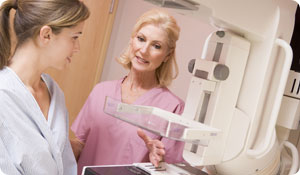
In late 2009, the U.S. Preventive Services Task Force (USPSTF) created a brouhaha among cancer organizations, physicians, women's advocacy groups, and patients when it released its updated mammography screening recommendations. Here are the highlights from these guidelines.
1. Who is the USPSTF and how did they arrive at these guidelines?
The USPSTF is an independent panel of doctors and scientists. The panel arrived at its recommendations by reviewing new and old studies and evaluating current evidence about the harms of mammography screening. The Task Force's ultimate goal when issuing guidelines is to define the lifetime benefits and harms for starting and stopping screening at different ages and for different screening intervals.
2. At what age should women now begin breast cancer screening?
The USPSTF recommends against routine screening mammograms before age 50 for women with no known risk factors. Here's why:
- Mammograms in women under 40 have lower rates of accuracy and detect few cancers.
- Women under 40 have low breast cancer rates, but a high rate of callbacks for additional screening following mammograms.
- These recalls lead to disproportionate rates of additional imaging while producing low breast cancer detection rates.
When the Task Force weighed the benefits of screening women younger than 50 and the harms incurred from screening, it determined the benefit did not warrant routine screening before 50.
3. What about women at high risk for breast cancer?
Women who have known risk factors for breast cancer should discuss when to begin screening with their physician. Normally, doctors don't recommend screening women younger than 40 because they tend to have denser breast tissue, which makes it more difficult for mammograms to detect cancer. Digital mammography, however, significantly improves detection for younger, high-risk women.
4. At what age should women stop having mammograms?
The USPSTF recommends discontinuing regular mammograms at 74 because there is insufficient evidence to evaluate the benefits and harms in older women.
5. Should women still perform Self-Breast Exams (SBEs)?
SBEs are not associated with a decrease in deaths from breast cancer so the Task Force recommends against teaching women this procedure.
6. How often should women have mammograms?
The Task Force recommends women 50 and older have mammograms every two years.
7. What should doctors tell their patients in light of these guidelines?
Physicians should inform women about the potential benefits of mammography screening (detecting cancer early enough to successfully treat it), potential harms (false positives, additional-unnecessary-procedures, which create stress and anxiety), and limitations of mammography (the procedure doesn't detect cancer 100 percent of the time).
Sources
U.S. Department of Health and Human Services. Agency for Healthcare Research and Quality. "Screening for Breast Cancer: Recommendation Statement." Web. December 2009.
http://www.ahrq.gov/clinic/uspstf09/breastcancer/brcanrs.htm#clinical
Barclay, Laurie, MD. "Screening Mammograms May Have Low Accuracy in Younger Women." Medscape Medical News. Web. 5 May 2010. http://www.medscape.com/viewarticle/721298
Mulcahy, Nick. "Mammography Should Begin at 40, Say New Recommendations." Medscape Medical News. Web. 6 January 2010. http://www.medscape.com/viewarticle/714670
Barclay, Laurie, MD. "New Breast Cancer Screening Guidelines Opposed by Societies." Medscape Medical News. Web. 19 November 2010. http://www.medscape.com/viewarticle/712720
U.S. Preventive Services Task Force (USPSTF). "Recommendation Statement From USPSTF: Screening for Breast Cancer." Medscape Medical News. Web. 17 December 2009.





